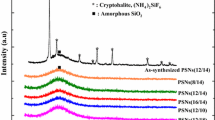Abstract
Carbon capture represents an integral part of the CO2 mitigation efforts, and involves the demonstration of effective and inexpensive CO2 capture technologies. We report the first demonstration of an amine-functionalized stellate macroporous silica as a platform for effective CO2 absorption, with potential application in current fossil-fuel burning plants. The work demonstrates that the facile impregnation of the silica platform with tetraethylenepentamine results in a high-performing sorbent for carbon dioxide. The CO2 absorption data exceed the performance of other reported silica–amine matrices for carbon capture, showing an amount of over 4 mmol CO2/g sorbent at low temperature, simulating the flue gas temperature. The platform is robust, showing recyclability and >85 % mass conservation of sorbent upon nine cycles. In addition, the stellate MSNs show high CO2 selectivity at room temperature, indicating that the presence of nitrogen in flue gas will not impair the CO2 absorption performance. The results could lead to a simple and inexpensive new technology for CO2 mitigation.








Similar content being viewed by others
References
Crowley TJ (2000) Causes of climate change over the past 1000 years. Science 289:270–277
Haszeldine RS (2009) Carbon capture and storage: how green can black be? Science 325:1647–1652
Han B, Zhou C, Wu J, Tempel DJ, Cheng H (2011) Understanding CO2 capture mechanisms in aqueous monoethanolamine via first principles simulations. J Phys Chem Lett 2:522–526
Figueroa JD, Fout T, Plasynski S, McIlvried H, Srivastava RD (2008) Advances in CO2 capture technology—the U.S. Department of Energy’s Carbon Sequestration Program. Int J Greenh Gas Control 2:9–20
Zhou Y, Liu J, Xiao M, Meng Y, Sun L (2016) Designing supported ionic liquids (ILs) within inorganic nanosheets for CO2 capture applications. ACS Appl Mater Interfaces 8:5547–5555
Shi Y-Q, Zhu J, Liu X-Q, Geng J-C, Sun L-B (2014) Molecular template-directed synthesis of microporous polymer networks for highly selective CO2 capture. ACS Appl Mater Interfaces 6:20340–20349
Liu F-Q, Wang L, Huang Z-G, Li C-Q, Li W, Li R-X, Li W-H (2014) Amine-tethered adsorbents based on three-dimensional macroporous silica for CO2 capture from simulated flue gas and air. ACS Appl Mater Interfaces 6:4371–4381
Wang J, Senkovska I, Oschatz M, Lohe MR, Borchardt L, Heerwig A, Liu Q, Kaskel S (2013) Imine-linked polymer-derived nitrogen-doped microporous carbons with excellent CO2 capture properties. ACS Appl Mater Interfaces 5:3160–3167
Luo XY, Ding F, Lin WJ, Qi YQ, Li HR, Wang CM (2014) Efficient and energy-saving CO2 capture through the entropic effect induced by the intermolecular hydrogen bonding in anion-functionalized ionic liquids. J Phys Chem Lett 5:381–386
Sun L-B, Li A-G, Liu X-D, Liu X-Q, Feng D, Lu W, Yuan D, Zhou H-C (2015) Facile fabrication of cost-effective porous polymer networks for highly selective CO2 capture. J Mater Chem A 3:3252–3256
Hahn MW, Jelic J, Berger E, Reuter K, Jentys A, Lercher JA (2016) Role of amine functionality for CO2 chemisorption on silica. J Phys Chem B 120:1988–1995
Didas SA, Choi S, Chaikittisilp W, Jones CW (2015) Amine-oxide hybrid materials for CO2 capture from ambient air. Acc Chem Res 48:2680–2687
Li K-M, Jiang J-G, Tian S-C, Chen X-J, Yan F (2014) Influence of silica types on synthesis and performance of amine-silica hybrid materials used for CO2 capture. J Phys Chem C 118:2454–2462
Zhang X, Zheng X, Zhang S, Zhao B, Wu W (2012) AM-TEPA impregnated disordered mesoporous silica as CO2 capture adsorbent for balanced adsorption–desorption properties. Ind Eng Chem Res 51:15163–15169
Berger E, Hahn MW, Przybilla T, Winter B, Spiecker E, Jentys A, Lercher JA (2016) Impact of solvents and surfactants on the self-assembly of nanostructured amine functionalized silica spheres for CO2 capture. J Energy Chem 25:327–335
Danon A, Stair PC, Weitz E (2011) FTIR study of CO2 adsorption on amine-grafted SBA-15: elucidation of adsorbed species. J Phys Chem C 115:11540–11549
Harlick PJE, Sayari A (2006) Applications of pore-expanded mesoporous silicas. 3. Triamine silane grafting for enhanced CO2 adsorption. Ind Eng Chem Res 45:3248–3255
Builes S, López-Aranguren P, Fraile J, Vega LF, Domingo C (2015) Analysis of CO2 adsorption in amine-functionalized porous silicas by molecular simulations. Energy Fuels 29:3855–3862
Zhang K, Xu L-L, Jiang J-G, Calin N, Lam K-F, Zhang S-J, Wu H-H, Wu G-D, Albela B, Bonneviot L, Wu P (2013) Facile large-scale synthesis of monodisperse mesoporous silica nanospheres with tunable pore structure. J Am Chem Soc 135:2427–2430
Thommes M, Kaneko K, Neimark A, Olivier J, Rodriguez-Reynoso F, Rouquerol J, Sing K (2015) Physisorption of gases, with special reference to the evaluation of surface area and pore size distribution (IUPAC Technical Report). Pure Appl Chem 87(9–10):1051–1069
Acknowledgements
The authors thank the U.S. Department of Energy for funding through grant number DE-FE0023541, and U.S. National Science Foundation under Grant No. 1458980 (N. Pizzi graduate stipend).
Author information
Authors and Affiliations
Corresponding author
Ethics declarations
Conflict of interest
The authors do not have competing interest and declare no conflict of interest.
Electronic supplementary material
Below is the link to the electronic supplementary material.
Rights and permissions
About this article
Cite this article
Radu, D.R., Pizzi, N.A. & Lai, CY. Functionalized stellate macroporous silica nanospheres for CO2 mitigation. J Mater Sci 51, 10632–10640 (2016). https://doi.org/10.1007/s10853-016-0284-y
Received:
Accepted:
Published:
Issue Date:
DOI: https://doi.org/10.1007/s10853-016-0284-y




